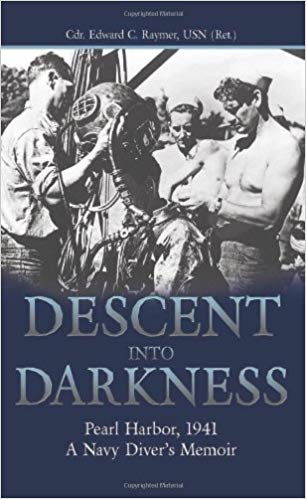
Book Review of
Descent Into Darkness
On December 7, 1941, as the great battleships Arizona, Oklahoma, and Utah lie paralyzed and burning in the aftermath of the Japanese attack on Pearl Harbor, a crack team of U.S. Navy salvage divers headed by Edward C. Raymer are hurriedly flown to Oahu from the mainland. The divers have been given a Herculean task: rescue the sailors and Marines trapped below, and resurrect the pride of the Pacific fleet.
Now for the first time, the chief diver of the Pearl Harbor salvage operations, Cmdr. Edward C. Raymer, USN (Ret.), tells the whole story of the desperate attempts to save crewmembers caught inside their sinking ships. Descent into Darkness is the only book available that describes the raising and salvage operations of sunken battleships following the December 7th attack.
Once Raymer and his crew of divers entered the interiors of the sunken shipwrecks–attempting untested and potentially deadly diving techniques–they experienced a world of total blackness, unable to see even the faceplates of their helmets. By memorizing the ships’ blueprints and using their sense of touch, the divers groped their way hundreds of feet inside the sunken vessels to make repairs and salvage vital war material. The divers learned how to cope with such unseen dangers as falling objects, sharks, the eerie presence of floating human bodies, and the constant threat of Japanese attacks from above.
Though many of these divers were killed or seriously injured during the wartime salvage operations, on the whole they had great success performing what seemed to be impossible jobs. Among their credits, Raymer’s crew raised the sunken battleships West Virginia, Nevada, and California. After Pearl Harbor they moved on to other crucial salvage work off Guadalcanal and the sites of other great sea battles.
Grace's Review

Decent into Darkness was a tough read because it was a slightly different World War II book.
I am glad I read it as it taught me a lot about diving, Pearl Harbor, World War II, and Edward Raymer. I found this story amazing. I guess I never realized how important divers where in World War II. I knew they were used, especially at Pearl Harbor, but this book taught me that they were even more important.
Instead of seeing people die by gunfire as much, Raymer sees other types of death and dead bodies. You can probably imagine what he saw diving after Pearl Harbor. He tells you some of it, and I am glad he did because it made me appreciate him and the other divers he talks about.
This book though has some weird and funny stories. I mean their is a really good one in the middle of the book that shows that people in charge sometimes are so incompetent and have the wackiest orders.
